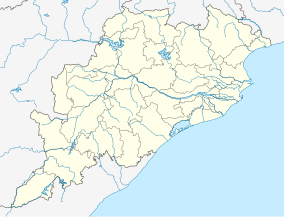The Kuldiha Wildlife Sanctuary (Odia: କୁଲଡିହା ବନ୍ୟଜନ୍ତୁ ଅଭୟାରଣ୍ୟ) is located at the Balasore district of Odisha, India. The sanctuary is spread across 272.75 km2 (105 sq mi) in the Chota Nagpur Plateau region. It is connected with Simlipal National Park via the Sukhupada and Nato hill ranges.
| Kuldiha Wildlife Sanctuary | |
|---|---|
| କୁଲଡିହା ବନ୍ୟଜନ୍ତୁ ସଂରକ୍ଷଣାଳୟ | |
IUCN category IV (habitat/species management area) | |
| Nearest city | Balasore |
| Coordinates | 21°12′N 86°18′E / 21.20°N 86.3°E |
| Area | 272.75 km2 (105.31 sq mi) |
| Designated | 4 January 1984 |
| Visitors | 6340 (in 2015)[1] |
| Governing body | Ministry of Environment, Forest and Climate Change, Government of Odisha |
| Website | www www |
Description
edit10miles
WS: Wildlife Sanctuary, WR: Water Reservoir, HT: Hill Top, O: Other importance
Note: Owing to space constraints in the small map, the actual locations in a larger map may vary slightly
Kuldiha was officially declared a sanctuary on 4 January 1984.[2] It is located in Kuldiha and is known for the Mayurbhanj Elephant Reserve (locally known as Tenda Elephant Reserve) which spreads across Simlipal, Kuldiha, and Hadgarh wildlife reserves.[3]
Aside from being an environmental reserve, the sanctuary offers night-stay accommodation at Kuldiha entrance, Jadachua, and Rishia in the form of huts, tents, and concrete houses. [4] A watch tower at Garsimulia allows for wildlife observation, [5] but is typically closed during the peak monsoon season due to heavy rains and flooding.[1]
In early 2012, a major fire was reported to have engulfed both Simlipal and Kuldiha forests, causing significant damage to their flora and fauna.[6] In the following year, on 2 August 2013, the Ministry of Environment, Forest and Climate Change (MoEFCC) declared the sanctuary an ecologically sensitive zone.[7]
Flora and fauna
editThe sanctuary is primarily composed of dense forests featuring sishu, sal, piyasal, mango, bahera, jamun, and simul trees. There are also 24 different species of orchid discovered so far.[8] There are also wild cats, elephants, long-tailed monkeys, leopards, gaurs, and giant squirrels. Bird species include peafowl, hill mynas, and hornbills. [5]
Tourism
editOdisha's government operates the Kuldiha sanctuary as a community-based PPP model with an ecotourism focus. [4][9][10][11]
See also
editReferences
edit- ^ a b "Kuldiha Sanctuary Closed". The New Indian Express. 16 June 2015. Archived from the original on 13 December 2015.
- ^ Ramakrishna; Zoological Survey of India (2006). Faunal resources of Similipal Biosphere Reserve, Mayurbhanj, Orissa. Kolkata: Zoological Survey of India. p. 3. ISBN 8181711149.
- ^ "Mayurbhanj Elephant Reserve". www.simlipal.org. Retrieved 27 May 2016.
- ^ a b Udgata, Harsha Bardhan (November 2012). "Eco-Tourism Destinations of Odisha" (PDF). Government of Odisha. p. 49.
- ^ a b "Kuldiha- A less known Forest". 6 September 2009.
- ^ "Forest fire engulfs Similipal, Kuldiha areas". news18. 8 March 2012.
- ^ "Submission of proposals to the States for declaration of Eco-sensitive Zones." (PDF). Ministry of Environment and Forests (India). 2 August 2013. p. 3.
- ^ Sharma, R P. The Indian Forester (Volume 122) (1996 ed.). University of Minnesota. pp. 927–931.
- ^ Raghu Prasad, R. "Ecotourism and Protected Areas: Contributing Community Development and Conserving Biodiversity, Piloted in Satkosia" (PDF). TERI University. Retrieved 30 May 2016.
- ^ "Ecotourism in Odisha". www.odishaecotourism.com. Retrieved 30 May 2016.
- ^ Barik, Bibhuti (June 2015). "Private push to eco-tourism". The Telegraph (Calcutta). Archived from the original on 5 August 2016.
External links
edit- Kuldiha Tourism Archived 26 November 2020 at the Wayback Machine
- About Kuldiha
